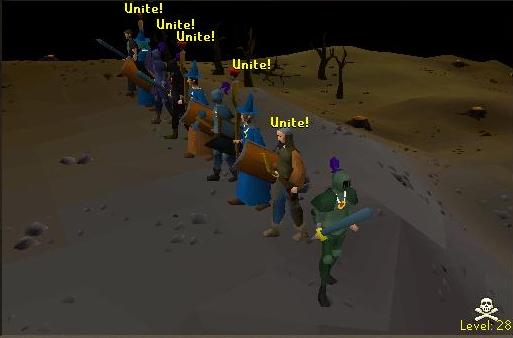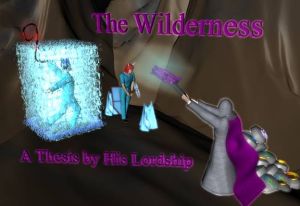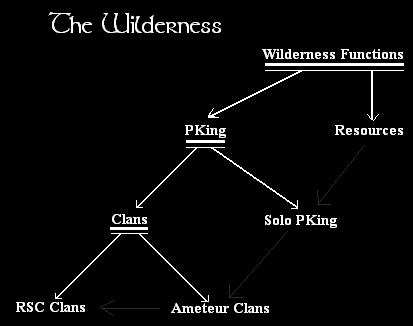Difference between revisions of "Wilderness Thesis (2006)"
| Line 82: | Line 82: | ||
[[File:Thesis Clan Image.jpg]] | [[File:Thesis Clan Image.jpg]] | ||
| − | ''Source: Wilderness Guardians Clan Archives Early 2004 (Raids)'' | + | <br>''Source: Wilderness Guardians Clan Archives Early 2004 (Raids)'' |
<p>These clan PK trips normally lack any grand organization. However, they remain successful through numbers. Being in the teleport zone they are quite safe. Popular places for such clans to visit are the Bandit Camp, Giants, and Dark Warrior Fortress. As the players become more experienced, and outgrow the low levels, they will soon develop advanced forum communication, and grow further and soon enter deeper levels of wilderness. On rare occasions, clans such as these enter deep wilderness.</p> | <p>These clan PK trips normally lack any grand organization. However, they remain successful through numbers. Being in the teleport zone they are quite safe. Popular places for such clans to visit are the Bandit Camp, Giants, and Dark Warrior Fortress. As the players become more experienced, and outgrow the low levels, they will soon develop advanced forum communication, and grow further and soon enter deeper levels of wilderness. On rare occasions, clans such as these enter deep wilderness.</p> | ||
Revision as of 23:13, 9 April 2025
- See also: Wilderness Thesis (2004)
The Wilderness Thesis is a document which comprehensively analyses the PvP clan community and practices within RuneScape around 2006. It was written by His Lordship and published to the Wilderness Guardians website sometime during or before June 2006[1], and supersedes the 2004 Thesis from two years previously. The full thesis is as follows, copied verbatim from the original apart from stylistic changes to fit the wiki format.
Contents
Preface: Author's Comments
I am very pleased to present you with this work, which is a culmination of many varied opinions of the Runescape people. This work is available for your use and leisure at any time. You may copy parts of it or take it entirely, but if you do so, please give due credit and a link back to this website.
This document was not meant to offer advice. It is only an explanation of how things work. For example, pretend the wilderness is a clock. All this document does, is tell you how this clock works. It doesn’t tell you how to repair it, or how to keep it in top condition. In essence, this thesis is just a summary of all that which occurs inside the wilderness. However, it does not mean this document does not have practical uses. Having a greater understanding of the wilderness will undoubtedly advance your ability to exploit it.
If you have any queries in regard to my thesis, or changes to make, send me a personal email, at [email redacted] and ensure you specify whether or not you would like a reply.
Introduction
There is no place in Runescape like the wilderness. It is the most dynamic and perpetual spread of land in the entire game. Players of all areas, from skills, to fighting, are drawn to it. It is quite safe to say, that the wilderness plays host to the most thrilling experience in Runescape.
Why?
Why is it that people feel safer walking through the Taverly Dungeon than browsing the wilderness? Why is it so less stressful to destroy a mighty dragon, than fight another player?
There is a human element. The human element creates chaos. Nothing is ever predictable. No fight will ever be the same, and no human is the same. This inability to predict an outcome is what thrills us. We fear that which we do not know. No amount of fights with the game’s fiercest creatures could ever compare.
This territory is mostly barren and uninteresting. In fact, it is the plainest setting on the map. Yet, out of this dead zone comes an intricate ballet of life, where the interplay of giants and dwarves plays on all the time. It can simultaneously accommodate a level three, fresh off tutorial island, to a large three hundred man clan, or a coal miner or explorer. And each of these groups has their own limits, and are bound together by the great chain of predation.
Indeed, the wilderness is more complicated than dressing up and walking out and tapping your sword against someone else’s flesh.
The thesis can be explained very simply with a diagram.
In this thesis, we begin by looking at what happens on the surface level. We can agree that the wilderness is designed for PKing and for the gathering of resources. The PKing category is far more complex than the resource counterpart. So then, we must focus more on PKing, and in the second section, we can again divide PKing into two categories. Solo PKing (Teams fall under solo PKing for a reason later to be explained) and Clans. Solo PKing is, again, far less complex than the clan world, and so we devote another chapter to the world of clans. Yet STILL, the world of clans is far too complex to explain in a single chapter, so we divide the clan world into those amateur clans, and the clans belonging to Runescape Community. And so the next chapter hones in on the Runescape Community clans, in particular, the concept of honour. This concept is unique to these clans. While it is possible to delve into more detail on RSC Clans, such a move would be too difficult, as the clan world, more than the rest of the wilderness, is dictated by the human mind, and therefore evolves and expands and cannot be explained properly.
After all this, we bind them all together in the chapter of the chain of predation, indicated by the grey arrows. Skill players become targets for Solo PKers, which become targets for amateur clans, which are targets of the legendary RSC clans. And so, we see how all aspects, from skills, to PKing solo, to clans, are all linked by this great chain.
Finally, to finish our thesis, we compare the vastly different worlds of P2P and F2P and show how the whole system differs.
And so we seek, in this thesis, to try and explain the great ecosystem that exists within the game we all know and love. Where better to start, than on surface level. Let us explore the wilderness, in its most basic form.
Functions of the Wilderness
There is a very strong and very incorrect notion that the wilderness is made only for PKing. Yes, it is true that the wilderness is primarily a territory in which players assemble to fight each other, but it is selfish to think only in this way. There is more than meets the eye.
Resources
How strange of JaGeX, to place rune rocks in the middle of a fighting zone. Is it not just a fighting zone? What would a warrior want with Rune Rocks?
Is it not odd, that Green Dragons can only be found in the wilderness? What about that Mage Arena? How very strange.
Perhaps, the wilderness is not entirely PKing after all. There are plenty of resources to be collected and harvested. To name the most common examples: Rune Rocks, Mage Arena, Green Dragons, White Berries, Agility Course, Coal Mines, Unicorns, Runecrafting Abyss, Wilderness Treasure Trails, Chaos Elemental, Rogue Thieving, Axe Hut Training Site, Fire Giant Training Site, Moss Giant Training Site, Ice Warrior Training Site, Lava Maze Chest, Red Dragons, Hellhounds for Slayer and Black Dragons.
It is fairly safe to say that the following two statements are correct. First, every committed Runescape player will enter the wilderness for resources numerous times in their careers, even as PKers. Second, It is not just inexperienced players who use the wilderness resources. Many high level players will continue to venture in for clue scrolls, rune mining, abyss Runecrafting, and so on and so forth. Obviously, this is less true of the free worlds.
In saying this, the resources of the wilderness do play a large role in the wilderness. The trend of JaGeX has been to open up MORE resources in the wilderness, to expand the non-PKing aspect. The statement “The wilderness is for PKing” is only part true. I good guess would be that 15% of all people in the wilderness through all the servers will be exploiting the resources of the wilderness.
PKing
Certainly the wilderness is primarily a PKing zone. This is common knowledge. Clans inhabit the vast majority of deep wilderness, whilst solo PKers wander the middle zones, and the inexperienced players test the waters in the shallow end. The types of PKing are numerous, and so varied that no document can seek to ever fully detail them. However, there are some mainstream forms that can be explained.
Low Level Fighting – This happens on the free worlds above Varrock, where lower levels battle opponents in low level wilderness. Rarely is a kill made as the losing opponent simply runs outside the wilderness in a few steps. Most people progress beyond this form of PKing, as it brings no kills, and the thrill tends to die away rapidly. On P2P, the story is different. The fights occur above Edgeville and are often deathmatches, where both parties agree not to take flight.
Castle PKing and Giant PKing – The next step in the progression of PKing takes the player to level 13-16 wilderness. The risk increases as the level difference increases as well. People fight each other near the Dark Warrior Fortress, or the Giants to the east. This level of wilderness is also within the teleport range and too often, players teleport out when losing a battle. Thus, kills in this spectrum of PKing are also rare. Players also tend to outgrow this style of PKing.
Deep Wilderness PKing – This is very much the epitome of solo PKing in f2p. Deep wilderness is overrun by clans, and solo PKers do not stand a chance against them. Therefore, solo PKers in f2p venture within f2p limits, particularly by the hobgoblin mine, moss giants, rune rocks, and ice plateau. These PKers often prey on skillers for whatever loot they can offer. These are easy kills, and very often a stronger solo PKer will find another solo PKer. This type of PKing brings more success in the form of loot. Clans do not venture into single combat as it is too difficult to co-ordinate a proper attack and the chance of a kill is low.
Lever PKing and Mage Bank PKing – The height of solo PKing in Runescape. Solo PKers often test their might in level 50 wilderness, non multi zones, such as the mage bank and Ardougne lever, where skillers and inexperienced PKers can be found. This form of PKing is highly dangerous and also very rewarding. The use of teleblock and freezing spells add extra risk.
Teaming – Consider all the above forms of PKing. Some players form small teams in which they can strengthen themselves and bring more success. Larger teams will frequently venture into multi combat in hopes of finding another team to defeat.
Finally, we arrive at the clan scenario. Clans are the ultimate PKing machines. They are numerous, and work together in defeating the opposition. In multi combat, teams and solo PKers stand no chance, and in single combat areas, their victims could not possibly stay and fight. Of all the ways to PK, PKing with a clan is the most intricate and complex of all. For this reason, an entire section of the thesis as been allotted to clans.
Clans
Consider the entire population of Runescape. Over a million players overall. How many would be in a clan? For the sake of generosity, say all clans, big and small, have an average member count of 80 (Remember there are far more small clans than there are large clans). That gives us 250 clans. Many of them won’t even have names or requirements. Yet, clans only comprise 2% of the entire population of Runescape. Yet, for such a small percentage, the wilderness is dominated by them. They are the governing forces of the wilderness. There will not be a 5 second period on a weekend where there is not at least three clans in the wilderness. And the stronger the clan, the more they are out there. In this chapter, we explore the world of the superpowers of Runescape.
PK Trips
The most basic and most common clan gathering is the PK trip. But the PK trip in itself is also varied. But essentially, the act is always the same. Head out in the hopes of killing, and to be the most powerful entity.
Starting clans often PK in the teleport zones. These clans are very simple clans with no website or forums, low levels, and cheap equipment.

Source: Wilderness Guardians Clan Archives Early 2004 (Raids)
These clan PK trips normally lack any grand organization. However, they remain successful through numbers. Being in the teleport zone they are quite safe. Popular places for such clans to visit are the Bandit Camp, Giants, and Dark Warrior Fortress. As the players become more experienced, and outgrow the low levels, they will soon develop advanced forum communication, and grow further and soon enter deeper levels of wilderness. On rare occasions, clans such as these enter deep wilderness.
For most clans however, deep multi combat wilderness is the best option. Heading deep in, many clans battle it out between each other, some fleeing from others. Some PK trips are held in the hopes of finding a few small teams and kills, while the bolder clans seek to spend their PK trips tracking down other clans. This happens only between the top 20 to 30 clans. Tracking down other clans leads into PK run ins. These result in vivid fights and can potentially create rivalries.
Wars
Runescape Community
Codes of Honour
Teleporting, Logging and Running
Crashing and PJing
AntiRPKing
Luring
Praying
Spying
Bad Equipment
The Chain of Predation
P2P vs. F2P Wilderness
Geography
Equipment
Distribution
Clan Wars
Conclusion
References
- ↑ The Wilderness, The Wilderness Guardians. Archived from the original on 28 June 2006, retrieved 9 April 2025.

